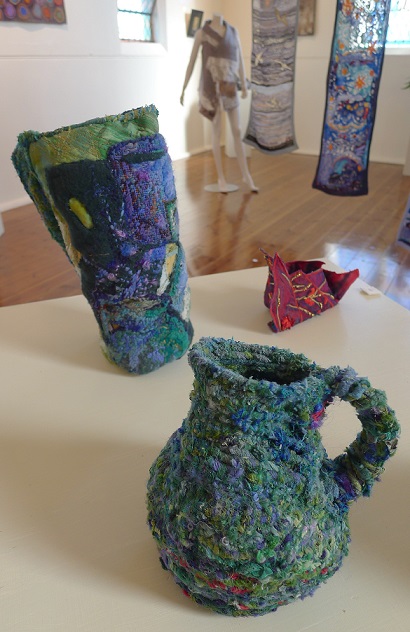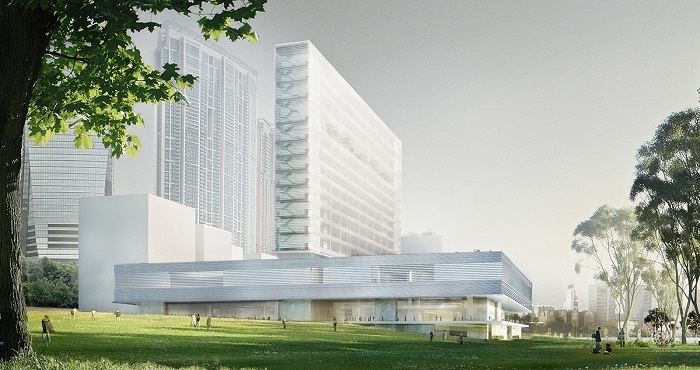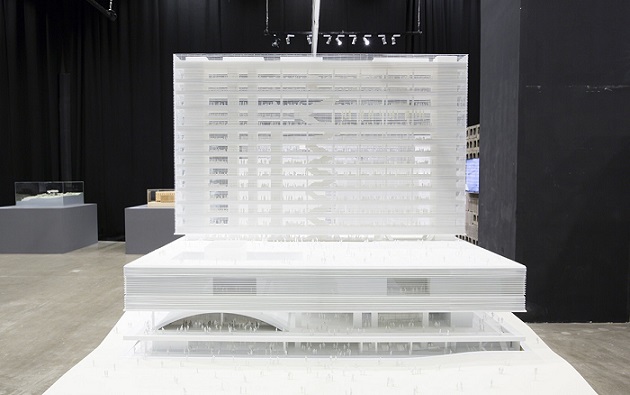藝術議題
- 西九文化區 / M+最新的專題文章如下。如欲閱讀有關同一議題的其他文章,可再點擊右下角資料庫的年份和月份。
Autonomy for Big (Hong Kong’s M+) and Small Art Spaces
約翰百德 (John BATTEN)
at 0:00am on 16th September 2014



Captions:
1. & 2. Interior of Red Rock Gallery and Theatre, near Colac, Australia.
3. & 4. Two architectural impressions of the M+ Museum, to be built at the West Kowloon Cultural District, Hong Kong.
(原文以英文發表,評論大(M +)小自治藝術空間的重要性。)
Just outside Colac, not far from the rugged world-renowned coastal cliffs of the Great Ocean Road, about 150 kilometres west of Melbourne in Australia is the Red Rock Theatre and Art Gallery. Recently, I visited the gallery and saw an excellent textile and fibre art exhibition complementing a larger exhibition at the local government funded Colac Otway Performing Arts & Cultural Centre (COPAC) – both exhibitions featuring local and regional artists and of excellent quality.
On another night, I attended a full-house physical theatre performance by New Zealand born, Melbourne-based “contemporary circus artist” Christy Flaws. She told her own and her grandmother’s life stories aided by rope, which was acrobatically twisted, knotted, climbed and unraveled in between serving tea, biscuits and generous tumblers of Kahlua & Ice to the audience while telling of life and occasional hard times in her hometown of Dunedin.
Based in a converted church (the gallery) and attached hall (the theatre) in the small community of Cororooke, Red Rock is the vision of – and substantially funded by - local dairy farmers Andrew and Mary Beale. Poignantly, but not obviously apparent, Red Rock’s Carolyn Theatre is dedicated to their young daughter who died in a car accident. Red Rock was initially a Beale family project, but increasingly involves a local community of many volunteer artists and arts supporters.
Red Rock is an excellent example of self-help and renewal in countryside areas whose traditional meeting-points of contact and mutual support (churches, post offices, shops, schools) are no longer viable or have already disappeared. While rapid and wide-ranging communication opportunities are available through the Internet, such virtual interaction can often emphasise (as researchers of the Internet are finding) loneliness and detachment – ultimately, there is no substitute for real human contact.
Since opening 18 months ago, Red Rock has hosted and organised a variety of live music nights, theatre and art exhibitions and members of its monthly film society watch and enthusiastically discuss international and art-house movies.
Cororooke comprises only a handful of houses, a general store, and country café. It is ostensibly an isolated community – but support is both potential and real: nearby Colac has a population of 11,000 and the Great Ocean Road attracts tourists from around the world. Farming communities, despite people, houses and properties being widely spread, are more cohesive than outsiders (read: urban city dwellers) realize. Red Rock demonstrates personal enthusiasm and perseverance and community initiative, but its most important attribute is its autonomy.
In contrast, Hong Kong is one of the most densely populated places in the world; however, its concrete high-rises and community have similarities with countryside Cororooke. Hong Kong, despite its larger population, also has few alternative, financially independent or artist-managed visual arts spaces. And government funding for the visual arts often comes with conditions: it is believed that the artist-initiative Woofer Ten, based at the Hong Kong Arts Development Council-managed Shanghai Street Art Space in Yau Ma Tei, lost its funding last year because its ‘non-art’ exhibitions were too political. Likewise, the inclusion of what is considered as too many overseas artists (including Ai Weiwei) in its exhibition programme lost Parasite in Sheung Wan its Arts Development Council funding, although it still receives substantial Home Affairs Bureau support.
On the future site of Hong Kong’s largest arts precinct, management autonomy and artistic and curatorial freedom is also being promoted. The West Kowloon Cultural District (WKCD) Authority outlined last month, for the first time, the future governance of the M+ museum. The Hong Kong arts community has long supported M+ having an independent governance structure and great autonomy. Reporting to the Legislative Council, the WKCD Authority Board – itself set-up as a statutory body under ordinance by the Legislative Council - explained that it “will (remain) the body setting overall policies for the governance of WKCDA, including M+, and the overall strategic direction for the WKCD.” However, M+ will be set-up as a separate legal entity and the new M+ Board will “develop the mandate/mission, vision and operating strategies for M+. M+ would retain control over its museological and curatorial policies and the M+ Board would hold the authority to approve the daily work and decisions within defined levels.”
This is excellent news. The world’s great art museums have a similar independent, autonomous structure. It means in the future M+ museum staff will have great curatorial independence with an accountable Board setting coherent organizational, exhibition and collection strategies. This is much better than the Leisure & Cultural Services Department’s museums (most notably the Hong Kong Museum of Art) which are run as divisions of a government department – creativity and public accountability cannot flourish in such a proscribed environment.
Some Legislative Council members have questioned this approach for M+, citing concern for “empire building.” Personal fiefdoms can be built under any structure, but an autonomous M+ is still statutorily accountable and, importantly, has responsibilities to Hong Kong’s public. I vote autonomy, any day.
This article was originally published in The Peak magazine, September 2014.
